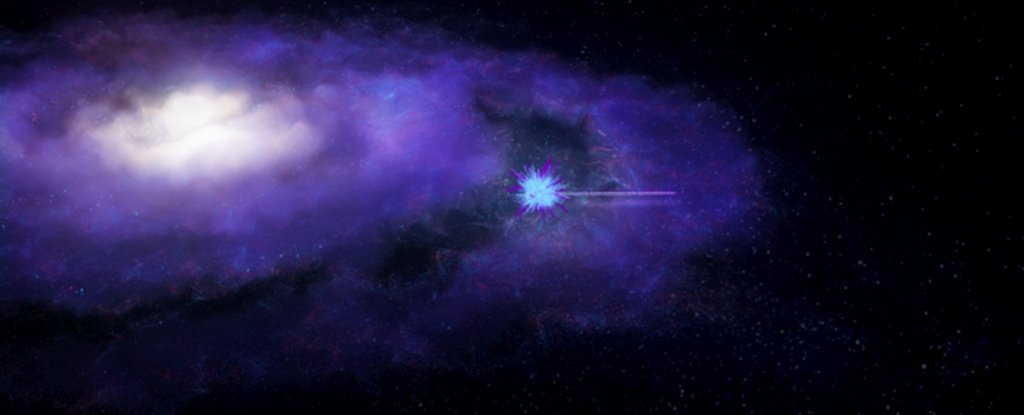
Scientists Have Used Fast Radio Bursts to Find The Universe's Missing Matter
by MICHELLE STARROne of the biggest cosmic mysteries has just been used to investigate another huge mystery. Astronomers used powerful bursts of radio waves traced back to distant galaxies to probe the space between the stars - and revealed where the Universe's missing matter has been hiding.
In the vast chasms that yawn between galaxies, gas so thin that it can't be detected by other instruments has stretched out those millisecond radio signals just enough so that we can measure it.
From those measurements, astronomers have found that extremely diffuse gas can account for all the missing 'normal' matter in the Universe.
"The discovery of fast radio bursts and their localisation to distant galaxies were the key breakthroughs needed to solve this mystery," said astronomer J. Xavier Prochaska of UC Santa Cruz.
The missing matter problem has long perplexed astronomers. We roughly know the matter-energy composition of the Universe. Around 68 percent of the Universe is dark energy, and 27 percent is dark matter. That's stuff we can't directly detect (nor do we know what it even is).
The remaining 5 percent is stuff we can detect - normal, or baryonic, matter, made up of baryonic particles. The stars, the planets, nebulas, plasma, even black holes are all made of baryonic matter. You and I are baryonic matter. It is the building block of everything we can see.
The radiation left over from the Big Bang that can be detected throughout the Universe - the Cosmic Microwave Background - lets us know how much baryonic matter was around at the beginning of the Universe. But a few decades ago, when astronomers started to compare that to the baryonic matter we can detect now, they only found about half as much as expected.
Where the rest went has been a mystery ever since, but we've had hints. Techniques such as analysis of the light travelling from distant quasar galaxies have revealed very specific, small amounts of atomic hydrogen, or material close to galaxies.
The scattering of the Cosmic Microwave Background photons by galaxy clusters, has revealed material close to galaxies, or within filamentary structures.
But farther away from galaxies, dark stretches of space are much more difficult to probe.
"Intergalactic space is very sparse. The missing matter was equivalent to only one or two atoms in a room the size of an average office," explained astronomer Jean-Pierre Macquart of the Curtin University, Australia node of the International Centre for Radio Astronomy Research.
"So it was very hard to detect this matter using traditional techniques and telescopes."
This is where fast radio bursts (FRBs) come in. These are extremely powerful bursts of radio waves from deep space, spewing out radiation equivalent to hundreds of millions of Suns, packed into a timeframe of just milliseconds. Most of them flare once, and have not been detected since. So they are extremely difficult to predict, and difficult to localise.
We don't know what they are (although evidence is increasingly pointing towards magnetars as at least one cause), but just in the last year, astronomers have figured out and refined how to trace these one-off signals back to the galaxies that spat them out.
This means we can calculate how far they have travelled. In turn, whether we know what produces them or not, FRBs have become a valuable tool for probing space.
That's because we know that the radiation leaves its source as a compact bundle across the radio spectrum. But when it arrives here, detected by our telescopes, the signal is stretched out, with some wavelengths hitting fractions of a millisecond before others. This can be analysed in the context of the distance travelled to calculate how much material the signal passed through, to create the drag required for that wavelength dispersion.
The team used this technique on a number of such newly localised fast radio burst signals, some from billions of light-years away, to calculate the gas content of the intergalactic medium.
"The radiation from fast radio bursts gets spread out by the missing matter in the same way that you see the colours of sunlight being separated in a prism," Macquart said.
"We've now been able to measure the distances to enough fast radio bursts to determine the density of the Universe. We only needed six to find this missing matter."
Radio signals aren't sufficient to determine the composition of the matter (it's probably predominantly hydrogen and helium), but the amount calculated from the FRBs was consistent with the amount of matter predicted from measurements of the Cosmic Microwave Background.
It's a stunning result, the best evidence yet that the missing matter is hiding in space that isn't so empty after all. But there's a lot more work to be done. This result is based on just a handful of signals - analysing more of them would help to characterise the matter more fully, providing not just a detection, but locations and how it is distributed.
Where the missing matter is most concentrated - around galaxies, or far from them - could then provide vital information that helps us understand how the Universe evolved.
The research has been published in Nature.